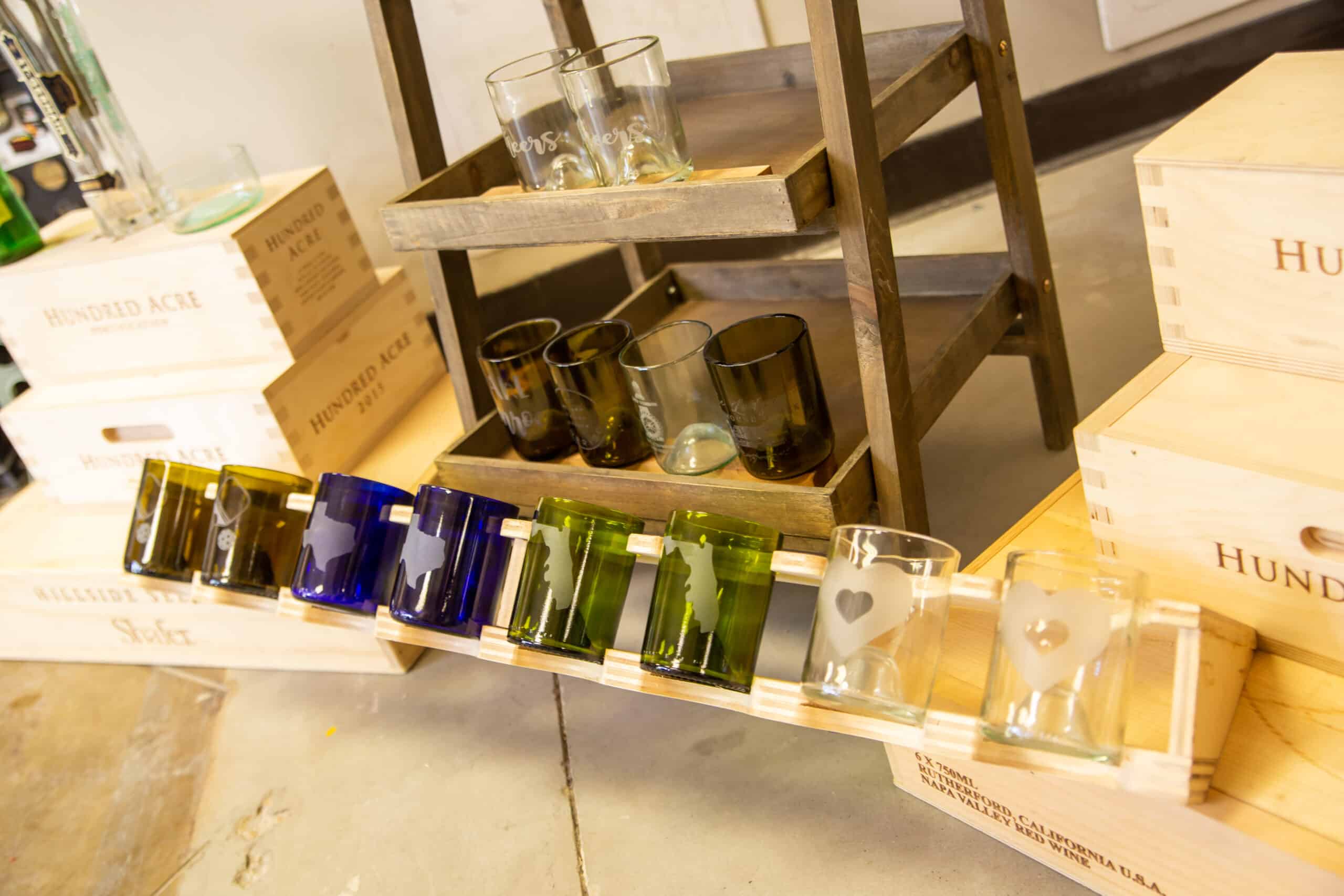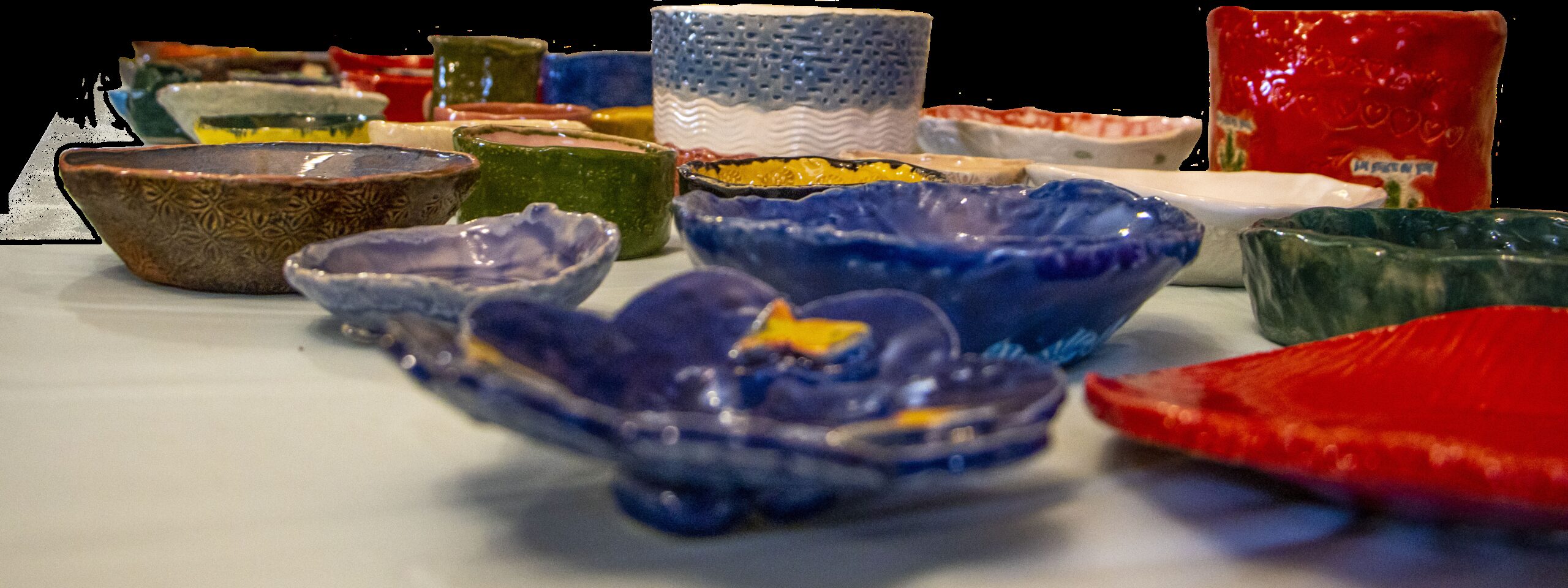
In 2018, Montgomery resident Brent Stokes, a global business executive, was enjoying dinner with colleagues in Chile when he learned about a nearby business endeavor. Vagrants collected wine bottles to earn a meager living, and a local company upcycled them, transforming them into drinkware. Brent was intrigued, and he purchased a set of glasses to bring home to his wife Scarlett.
Then he thought about it some more. “I think we can take a wine bottle and make it into drinkware,” he told Scarlett. “He started playing around with it in the garage, trying to figure out how to make it work,” Scarlett says. Six months later, the project was too big for the family’s garage, sending the Stokes family scrambling to find a suitable production facility. Scarlett took care of the business end of things and became the business’ CEO, making A Second Round Glass, LLC a woman-owned business with Brent as president. Brent and Scarlett’s son Brandon, a pole vaulter, was attending the University of Arkansas on track and academic scholarships. When he graduated, he became the company’s vice-president.
A Second Round has continued to grow. Today, it has nearly outgrown its headquarters on McCaleb Road. The Stokes family—with help from employees and creative friends—has perfected a system of upcycling bottles, transforming them not only into personalized, artisanal drinkware–but also home goods, such as lamps and planters.
Rescue: Every Monday, employees of A Second Round pick up a truckload of empty bottles at Bernhardt Winery, and hundreds more at West Sandy Creek Winery. “We call this ‘rescuing’ the bottles,” Brent says. Several restaurants and wineries, including Breakwater Grill, Walden Yacht Club, H Wines, and The Rancher’s Daughter (to name just a few), also contribute their empties to A Second Round; individuals contribute, too. The Stokes family calls these partners “the bottle brigade,” and rewards them with a discount on upcycled products.
Cleaning: The first step in the upcycling process is to remove labels and clean adhesive from bottles. Some bottles have labels that are painted on, so they can start their second lives while still displaying their original brand.
Cutting: As recently as a year ago, A Second Round used a labor-intensive process to cut wine bottles. First, they scored the bottles at the appropriate places to create glasses holding 8, 10, 12 and 16 ounces. Next, they heated them, and then plunged them into an ice bath, which cleanly split the bottles. To save time during production, Brent experimented with a specialized saw to accomplish the task. The method worked, so he soon upgraded to a larger saw. It’s quicker than the old method of splitting bottles, and what’s more, it leaves a smoother finish, making the next step necessary for only about 20 percent of bottles. “With the old technique, they had imperfections every single time,” Brandon says.
Sanding: “In the beginning we sanded by hand,” Scarlett says, “but we are small, so we don’t have a lot of hands.” The Stokes family clearly needed a more efficient system of smoothing out imperfections in the cut edges of wine bottles, but they could not find a suitable product on the market. So, as they have done many times, they carefully considered the problem, thinking creatively; eventually, they “Frankensteined” a belt sander and a vacuum device.
Fire polish: To glaze the rim of glasses, A Second Round uses what Brandon calls “misapplied technology.” Glasses are placed on inverted pie tins atop an old-fashioned record player. As the turntable spins, the rim of each glass is torched in a gas flame, one at a time, until the rim of the molten glass glows red. The record player seemed like a great idea, but, Brandon confesses, “We burned the first one to a crisp.” A heavy-duty silicone hot pad, placed under the pie tins, solved the problem. Brandon taught Ethan Yost, A Second Round’s first full-time employee, the heat-polishing technique, but Brandon says the student has now surpassed the teacher. “Ethan can glaze in his sleep,” he says. Gravity takes over at this point, “slumping” the glazed rim into a rounded edge.
Annealing: After each glass is glazed, it is placed in an enormous cooler, which holds up to 42 glasses. “The cooler used to be on my boat,” Scarlett says with a laugh. Inside the cooler, the glasses cool slowly, giving them added strength. The glasses stay in the “annealer” overnight. “They are very durable because of this process,” Brandon says.
Carbon removal: Unfortunately, the glasses acquire a buildup of carbon during the fire glazing process. Some of it can be wiped off with a cloth, but carbon can also penetrate the molecules of the glass. In the early days of production at A Second Round, carbon deposits were scrubbed off the low-tech way—with a Brillo pad. At one point, a Sam Houston State University Band tuba player (who was interning during the summer at A Second Round) put his internet skills to work in hopes of finding a better way to remove carbon. He was successful. Today, glasses are soaked in a compound that quickly removes the carbon. (The intern was rewarded.)
Personalization: Glasses are now etched with a myriad of designs. Some are semi-standardized, such as wedding motifs that can be modified to include names and dates, and A Second Round also makes fully customized drinkware. Designs were once sandblasted, but going forward, most will be etched with a laser engraving machine.
Finishing process: Finally, glasses are put to the test by subjecting them to heat. If a glass is going to break, the folks at A Second Round would rather it break in the production facility instead of in a customer’s home. Glasses, Brandon notes, are dishwasher safe.
Packaging and shipping: While many of their glasses and home goods are sold at craft and home interior shows, such as Lone Star First Saturday in Montgomery, others are ordered via A Second Round’s website, a2round.com, and are shipped to customers. Demand is increasing, so A Second Round actively encourages its “bottle brigade” to continue contributing bottles. “We don’t want to generate demand for a product we can’t fulfill,” Brandon says.
While recycling uses discarded products to make new ones of the same type, Brandon explains that upcycling takes a product that has already been used and converts it into another usable product. A Second Round does both. Although both the tops and bottoms of bottles are used to make glasses and home goods, not every piece of glass is needed, and there is some breakage. However, A Second Round Glass dutifully recycles unusable glass so that it can be recycled into the wine bottles of tomorrow. “We produce as little waste as possible,” Brandon says. “Everything that comes through here either goes into making glasses or it gets recycled into what it once was.”
With time, and thanks to suggestions from people in the community, A Second Round has discovered new ways to upcycle wine bottles. The company now offers a variety of decorator items, such as lamps and windchimes, and some bottles start their second lives while still holding on to the vestiges of their first lives.
For example, Coca-Cola purchased Topo Chico, one of A Second Round’s contributing partners, in 2017. Before the acquisition, labels were painted on bottles, and upcycled Topo Chico glasses with labels intact are popular with customers. (Unfortunately, it’s getting harder to find bottles with painted labels, which are identifiable by a yellow bar code. A Second Round now offers a bounty of $1 for each painted-label Topo Chico bottle.) Furthermore, some wine bottles have dimples—called punts—in the bottom. While glasses with punts look a bit unusual, some customers prefer them. “Some people like the punt because they get to brag on themselves that they are making a difference,” Brandon says with a smile.
The Stokes family is proud their company is able to rescue wine bottles and give them a new purpose. Meanwhile, the local community has embraced the idea. Some support the business by donating empty bottles, while others find joy in purchasing upcycled products. Brandon has observed that A Second Round’s success has been due, in large part, to a growing buzz in the community. “It’s native, locally driven traffic,” he says, “and we are passionate about supporting our community.”
For more information, to shop, or to learn how to donate bottles, visit a2round.com.

Postcards Magazine
936-293-1188
PO Box 690
Huntsville, TX 77342
